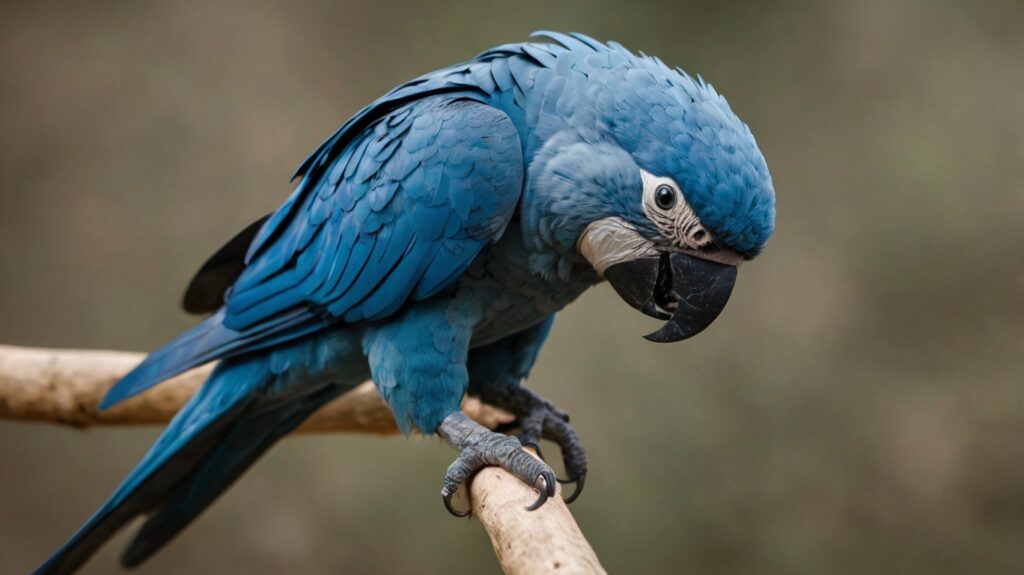Table of Contents
- Introduction
- Physical Characteristics
- Habitat and Distribution
- Behavior and Diet
- Conservation Status
- Efforts to Save the Spix’s Macaw
- Conclusion
- FAQs
Introduction
The Spix’s Macaw (Cyanopsitta spixii), also known as the Little Blue Macaw, is one of the rarest birds in the world. Native to Brazil, this striking blue parrot gained global fame through the animated movie Rio. Unfortunately, it is classified as Extinct in the Wild by the IUCN, with only a few individuals surviving in captivity. This article explores its characteristics, habitat, conservation efforts, and the challenges it faces.

Physical Characteristics
The Spix’s Macaw is a medium-sized parrot, measuring about 55–57 cm (22 in) in length. Key features include:
- Vibrant blue plumage with a greyish head
- Long tail and strong beak adapted for cracking nuts
- Pale blue underside and dark blue wings
- Yellowish eye ring in adults
Unlike other macaws, it has a more slender body, making it distinct in appearance.
Habitat and Distribution
Originally, the Spix’s Macaw was found in the Caatinga dry forests of northeastern Brazil. Its natural habitat consisted of:
- Gallery forests near seasonal rivers
- Tabebuia caraiba trees, where it nested
- Arid scrublands with limited water sources
Due to habitat destruction and illegal trapping, its wild population disappeared by the early 2000s.
Behavior and Diet
The Spix’s Macaw is known for its shy and quiet nature. Key behavioral traits include:
- Monogamous bonding (pairs for life)
- Diet primarily of seeds, nuts, and fruits
- Nesting in tree cavities
- Limited vocalizations compared to other macaws
Conservation Status
The IUCN Red List classifies the Spix’s Macaw as:
- Extinct in the Wild (EW) since 2019
- Critically Endangered (CR) for captive populations
Threats to Survival
- Deforestation for agriculture
- Illegal wildlife trade (high demand as exotic pets)
- Climate change affecting its arid habitat
Efforts to Save the Spix’s Macaw
Several initiatives aim to reintroduce the species into the wild:
- Captive Breeding Programs (e.g., ACTP in Germany)
- Habitat Restoration in Brazil’s Caatinga
- Reintroduction Projects (planned releases in protected areas)
- International Collaboration (governments & NGOs)
In 2022, eight Spix’s Macaws were released in Brazil, marking a hopeful step toward recovery.
Conclusion
The Spix’s Macaw remains a symbol of both wildlife conservation challenges and hope for recovery. While extinct in the wild, captive breeding and habitat restoration offer a chance for its return. Public awareness and stricter anti-trafficking laws are crucial to ensuring this majestic blue parrot does not vanish forever.
FAQs
1. Is the Spix’s Macaw really extinct in the wild?
Yes, the last wild Spix’s Macaw disappeared in 2000, and the species was declared Extinct in the Wild in 2019.
2. How many Spix’s Macaws are left in captivity?
As of 2024, around 160–200 individuals exist in breeding programs worldwide.
3. Why is the Spix’s Macaw called the “Little Blue Macaw”?
Due to its smaller size compared to other blue macaws like the Hyacinth Macaw.
4. Can the Spix’s Macaw be kept as a pet?
No, it is protected under international law, and private ownership is illegal.
5. Will the Spix’s Macaw ever return to the wild?
Reintroduction efforts are ongoing, with eight birds released in 2022, but long-term success depends on habitat protection.
